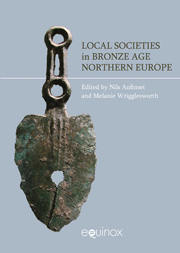Book contents
- Frontmatter
- Contents
- List of figures and tables
- Contributors
- Acknowledgements
- Introduction: local societies, regions and processes of cultural interaction in the Bronze Age
- PART I IDENTITY, GRAND NARRATIVES AND NETWORKS
- PART II REGIONS, GLOBALIZATION AND RESISTANCE
- 7 Northwestern Russia at the periphery of the north European and Volga-Uralic Bronze Age
- 8 Local centres in the periphery: the Late Neolithic, Bronze Age and Early Metal Age in Finland
- 9 The Nordic Bronze Age and the Lüneburg culture: two different responses to social change
- 10 Pottery, transmission and innovation in Mälardalen
- 11 Social landscapes of Bronze Age Scandinavia
- 12 The origin of a Bronze Age in Norway: structure, regional process and localized history
- 13 Social response or resistance to the introduction of metal? Western Norway at the edge of the “globalized” world
- Index
11 - Social landscapes of Bronze Age Scandinavia
from PART II - REGIONS, GLOBALIZATION AND RESISTANCE
- Frontmatter
- Contents
- List of figures and tables
- Contributors
- Acknowledgements
- Introduction: local societies, regions and processes of cultural interaction in the Bronze Age
- PART I IDENTITY, GRAND NARRATIVES AND NETWORKS
- PART II REGIONS, GLOBALIZATION AND RESISTANCE
- 7 Northwestern Russia at the periphery of the north European and Volga-Uralic Bronze Age
- 8 Local centres in the periphery: the Late Neolithic, Bronze Age and Early Metal Age in Finland
- 9 The Nordic Bronze Age and the Lüneburg culture: two different responses to social change
- 10 Pottery, transmission and innovation in Mälardalen
- 11 Social landscapes of Bronze Age Scandinavia
- 12 The origin of a Bronze Age in Norway: structure, regional process and localized history
- 13 Social response or resistance to the introduction of metal? Western Norway at the edge of the “globalized” world
- Index
Summary
Why do some material expressions have an uneven distribution (i.e. they occur in large numbers in some regions and in limited, or very few numbers, in other regions)? A similar uneven distribution of material culture expressions could also be studied on a smaller-scale level, where certain locales are loaded with symbolic expressions that make them stand out as unique in a comparative perspective.
In Scandinavian Bronze Age research, the uneven distribution of bronze items, rock art and burial monuments has often been explained by referring to individuals. In this explanatory framework the irregular distribution of valuable objects, symbolic expressions and monuments reflects the power of individuals (i.e. chiefs who through their supreme position were able to channel labour into monumental and symbolic manifestations of power; Larsson 1986; Kristiansen 1998; Kristiansen & Larsson 2005).
In this chapter I propose a shift in focus from individuals to the geographical framework that power operated within. The power of individuals was linked to networks with a spatial extension. Even though there were contacts over very large distances in the Bronze Age (Kristiansen & Larsson 2005), the chiefs – or people in command of power – operated within smaller regions on an everyday basis.
As pointed out by Adam T. Smith on the background of a study of early complex polities, politics is not directly about territories, or urbanism or architecture; it is about the production and reproduction of authority. However, authority is constantly constituted in the ordering of landscapes (Smith 2003: 280).
- Type
- Chapter
- Information
- Local Societies in Bronze Age Northern Europe , pp. 201 - 214Publisher: Acumen PublishingPrint publication year: 2012



